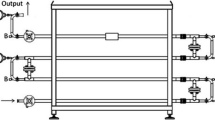Abstract
Thermal microbial inactivation kinetics can be influenced significantly by the non-isothermal condition of the sample tested. In many instances, it is practically difficult to maintain the temperature constant during chemical and biological reactions. To minimise error caused by such non-isothermal condition, an effective treatment temperature was derived based on fundamental principles of reaction kinetics. This effective temperature was significantly different from the arithmetic mean temperature due to the exponential effect of temperature on reaction rate. In order to validate the developed concept, Escherichia coli ATCC 25922 suspended in simulated milk ultra filtrate was thermally inactivated using test tubes of different diameters. As expected, the D value was accurately related to the water bath temperature only when small capillary tube was used for the measurements. As the tube diameter increased, the D value increased and was found not to be related to the water bath temperature. On the other hand, the measured D values using different tube diameters correlated very well with the calculated effective treatment temperature. Our calculations show that the effective temperature can be calculated with reasonable degree of accuracy even if there is some uncertainty in the value of the activation energy of the reaction. A number of important applications are addressed in this paper to show the importance of using such a concept. The use of effective temperature will allow accurate comparison of reaction kinetics reported in the literatures on chemical and biological reactions.








Similar content being viewed by others
Abbreviations
- A :
-
Heat transfer surface area, m2
- A i :
-
Pre-exponential factor, s−1
- Bi :
-
Biot number = hd/k
- Cp :
-
Specific heat capacity, J/kg K
- d :
-
Diameter = 2r, m
- E :
-
Activation energy, J/mol
- h :
-
Heat transfer coefficient, J/s kg K
- k :
-
Reaction rate constant, s−1
- k:
-
Thermal conductivity, J/s m K
- m :
-
Mass, kg
- n :
-
Number of measuring points
- R :
-
Gas constant, J/mol K
- T :
-
Temperature, °C
- T i :
-
Initial temperature, °C
- T ∞ :
-
Heating fluid temperature, °C
- T eff :
-
Effective temperature, °C
- t :
-
Time
- ρ :
-
Density, kg/m3
- τ :
-
Time constant, s
References
Alkhafaji, S. & Farid, M. M. (2007). An investigation on pulsed electric fields technology using new treatment chamber design. Innovative Food Science and Emerging Technologies, 8, 205–212.
Barbosa-Canovas, G. V., Zhang, Q. H., & Tabilo-Munizaga, G. (2001). Pulsed electric fields in food processing: fundamental aspects and applications. Lancaster: Technomic Pub. Co.
Chung, H.-J., Wang, S., & Tang, J. (2007). Influence of heat transfer with tube methods on measured thermal inactivation parameters for Escherichia coli. Journal of Food Protection, 70(4), 851–859.
El Bedawi, A. & Hamid, M. A. (1995). Storage conditions in the Sudan using the kinetic mean temperature concept. Drug Development and Industrial Pharmacy, 21, 731–738.
Fletcher, G. C., Youssef, J. F., & Gupta, S. (2008). Research issues in inactivation of Listeria monocytogenes associated with New Zealand greenshell mussel meat (Perna canaliculus) using high pressure processing. Journal of Aquatic Food Product Technology, 17, 173–194.
Ghani, A. G. & Farid, M. M. (2006). Using the computational fluid dynamics to analyze the thermal sterilization of solid-liquid food mixture in cans. Innovative Food Science and Emerging Technologies, 7, 55–61.
Haynes, J. D. (1971). Worldwide virtual temperature for product stability testing. Journal of Pharmaceutical Sciences, 60, 927–929.
Holman, J. P. (2002). Heat Transfer (9th ed.). New York: McGraw-Hill.
Hsu, H. C., Ju, H. L., & Chen, C. Y. (1997). The mean kinetic temperature and relative humidity for drug and products stability testing in Taiwan. Journal of Food and Drug Analysis, 5, 179–184.
Pothakamury, U. R., Monsalve-Gonzalez, A., Barbosa-Canovas, G. V., & Swanson, B. G. (1995). Inactivation of Escherichia coli and Staphylococcus aureus in model foods by pulsed electric field technology. Food Research International, 28(2), 167–171.
Rajan, S., Ahn, J., Balasubramaniam, V. M., & Yousef, A. E. (2006). Combined pressure-thermal inactivation kinetics of Bacillus amyloliquefaciens spores in mashed egg patties. Journal of Food Protection, 69, 853–860.
Ramaswamy, H. & Marcotte, M. (2006). Food processing principles and applications. USA: Tayler and Feancis Group. Courtesy of Tetra Pak Canada, Inc., Richmond Hill.
Shao, Y. & Ramaswamy, S. (2008). Clostridium sporogenes-ATCC 7955 spores destruction kinetics in milk under high pressure and elevated temperature treatment conditions. Food and Bioprocess Technology, doi:10.1007/s11947-008-0165-8.
Shao, Y., Zhu, S., Ramaswamy, S., & Marcotte, M. (2008). Compression heating and temperature control for high-pressure destruction of bacterial spores: an experimental method for kinetics evaluation. Food and Bioprocess Technology. doi:10.1007/s11947-008-0057-y.
Sun, D. W. (2005). Emerging technologies for food processing. USA: Elsevier Academic Press.
Vicente, G., Martinez, M., Aracil, J., & Esteban, A. (2005). Kinetics of sunflower oil methanolysis. Industrial & Engineering Chemistry Research, 44, 5447–5454.
Author information
Authors and Affiliations
Corresponding author
Rights and permissions
About this article
Cite this article
Farid, M., Alkhafaji, S. Determination of an Effective Treatment Temperature of Chemical and Biological Reactions. Food Bioprocess Technol 5, 147–154 (2012). https://doi.org/10.1007/s11947-009-0289-5
Received:
Accepted:
Published:
Issue Date:
DOI: https://doi.org/10.1007/s11947-009-0289-5




